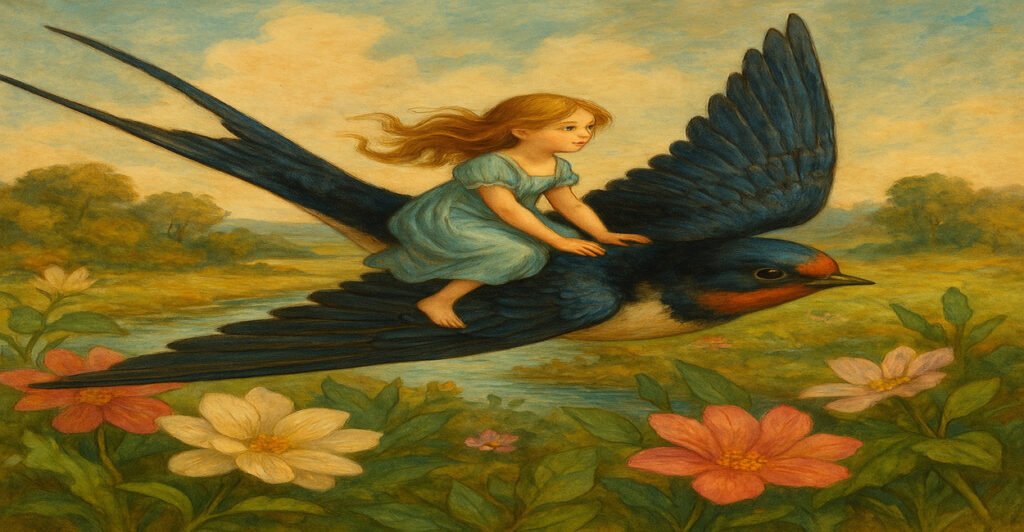Want to Read Stories?
Want to Read Stories?

Have you ever imagined a world where a girl no bigger than a thumb embarks on grand adventures? Thumbelina, the beloved fairy tale by Hans Christian Andersen, has enchanted generations with its story of courage, resilience, and the home search.
In this blog, we’ll dive deep into Thumbelina’s journey, analyzing its themes, uncovering hidden life lessons, and exploring why this fairy tale remains relevant today. Whether you’re revisiting this classic story or discovering it for the first time, you’ll see why this story continues to inspire readers of all ages.
The story begins with a lonely woman who longs for a child. A kind witch gives her a magical barleycorn, which blooms into a flower, and inside lies a tiny girl no bigger than a thumb. Thus begins the extraordinary journey of her, a delicate yet determined heroine.
A greedy toad kidnaps Thumbelina, intending to marry her. She escapes with the help of friendly fish. This early challenge shows her quick thinking as she enlists nature’s help to gain freedom. The scene also introduces the theme of unwanted obligations that will recur throughout her journey.
A beetle finds her beautiful at first, but later abandons her when others mock her differences. This painful episode highlights society’s fickle nature and superficial judgments. Her experiences her first taste of loneliness, foreshadowing her ongoing search for true acceptance.
A kind field mouse shelters her but pressures her to marry a wealthy (but cold-hearted) mole. This segment explores the conflict between security and happiness, as her faces societal expectations. The dark, underground setting mirrors the emotional confinement of an unwanted marriage proposal.
A swallow, whom Thumbelina nursed back to health, carries her to a magical land of flowers. This act of kindness repaid demonstrates the story’s moral about compassion creating its rewards. The soaring flight symbolizes her transition from survival to hopeful new beginnings.
She finally finds her true home with a tiny prince who is just her size. This satisfying conclusion reinforces the fairy tale’s message about finding one’s rightful place in the world. The flower kingdom represents both literal and metaphorical blossoming, completing her transformative journey.
While staying true to the original fairy tale, my version of Thumbelina emphasizes her inner strength and agency. Instead of passively waiting for rescue, she actively seeks freedom, making choices that lead her to happiness.
Thumbelina isn’t just a charming fairy tale; it’s packed with powerful messages that resonate even today. Let’s explore the key themes.
Thumbelina faces constant threats, kidnapping, abandonment, and forced marriage, yet she never gives up. Instead of succumbing to fear, she finds clever ways to escape (like convincing fish to chew through her lily pad). Her small stature becomes irrelevant as her big courage shines through each challenge. The story beautifully illustrates how resourcefulness and determination often outweigh physical strength.
This theme teaches children (and adults) that bravery isn’t about size, it’s about heart.
It’s a great lesson for overcoming bullying, standing up for oneself, and persisting through tough times.
Modern readers can apply this to facing life’s obstacles, from workplace challenges to personal struggles.
Throughout her journey, Thumbelina is misunderstood and rejected by the toads, beetles, and even the mole who sees her as a prize rather than a person. Her emotional journey mirrors the universal human experience of seeking acceptance. The story suggests that belonging isn’t about changing yourself to fit in, but finding where you naturally flourish.
Many people struggle with feeling out of place, whether in school, work, or society.
Thumbelina reminds us that true belonging comes from being accepted for who you are, not forced to conform.
In our digital age where social media often pressures people to present curated versions of themselves, this message is more relevant than ever.
Many characters try to use Thumbelina for their gain:
The toad wants her as a daughter-in-law.
The beetle discards her when she’s no longer fashionable.
The mole values wealth over love.
These interactions create a powerful contrast between transactional relationships and genuine care.
True kindness is selfless, like the swallow who repays Thumbelina’s help by taking her to a better life.
It’s a great way to discuss healthy relationships with young readers.
The story teaches that real connections are built on mutual respect, not what someone can gain from you.
Each creature tries to trap Thumbelina in their world:
The toad’s swamp (damp and restrictive).
The mole’s underground tunnel (dark and lifeless).
These physical spaces symbolize different forms of emotional and psychological confinement that people experience.
These settings represent societal pressures that limit individuality.
The flower kingdom, where she finally finds freedom, symbolizes self-discovery and true happiness.
Thumbelina’s journey teaches that breaking free from others’ expectations is essential for personal growth and fulfillment.
Fairy tales endure because they speak to universal human experiences. Here’s why Thumbelina remains timeless.
Everyone roots for the small hero overcoming big challenges just like Thumbelina. Her tiny stature makes her victories all the more inspiring, proving that true strength comes from within. In a world that often favors the powerful, Thumbelina gives hope to anyone who’s ever felt small or overlooked. The story teaches us that perseverance and cleverness can triumph over brute strength.
Unlike some passive fairy-tale heroines, Thumbelina takes action, making her a great role model for kids. She doesn’t wait to be rescued but instead uses her wits to escape dangerous situations. This active approach to problem-solving shows children they have agency in their own lives. Thumbelina demonstrates that even the smallest person can take control of their destiny.
With its flowers, animals, and natural settings, Thumbelina subtly teaches respect for nature, a relevant theme today. The story highlights the interconnectedness of all living things, from the helpful fish to the kind swallow. In an era of environmental awareness, Thumbelina reminds us of our responsibility to protect the natural world. The fairy tale’s vivid natural imagery also fosters appreciation for Earth’s beauty.
No matter how bleak things seem, Thumbelina reminds us that happiness can be found if we keep searching. Her journey from hardship to joy offers comfort during difficult times. The story’s happy ending reinforces the idea that dark periods are temporary. Thumbelina ultimately celebrates the human spirit’s ability to endure and find light in darkness.
Thumbelina isn’t just a story to read, it’s a mirror reflecting our struggles, triumphs, and journeys. Here are some thought-provoking questions to ponder and discuss:
Thumbelina teaches us that size doesn’t define strength, but have you ever felt underestimated or overlooked? Maybe it was speaking up in a meeting, standing up to a bully, or pursuing a dream others thought was “too big” for you. Share your story in the comments! How did you find your courage? Did you, like Thumbelina, discover hidden strengths when faced with adversity?
“Think of a time you felt small but stood tall. What did that experience teach you?”
Let’s reimagine this classic for today’s world!
Thumbelina is more than a fairy tale; it’s a story about courage, resilience, and finding where you truly belong. Whether you’re reading it to a child or revisiting it as an adult, its lessons remain powerful, reminding us that even the smallest among us can create big change. The story’s enduring appeal lies in its ability to speak to anyone who’s ever felt lost, underestimated, or trapped by circumstances.
At its heart, Thumbelina is a celebration of the human spirit of perseverance in the face of adversity and the belief that happiness is worth searching for. It teaches us that true belonging isn’t about fitting into someone else’s world, but finding the place where we can bloom.
Join our community of story writers crafting original fiction across genres. Get published, be read, and make an impact.

Take our 10-minute quiz, with lifelines and swapping options, for a quick and reliable snapshot of your English proficiency.
Lorem ipsum dolor sit amet consectetur adipisicing elit. Quas magni cupiditate aliquauibusdam nostrum accusantium fuga delectus quo exercitationem!
Where Every Story Sparks a New Adventure!
At Storyious, talented writers transform their ideas into captivating narratives that inspire, entertain, and connect readers of all ages. With a deep commitment to creativity and excellence, every story we publish is authentic, human-crafted, and carefully curated to spark imagination and leave a lasting impact.
Stay connected with Storyious! Subscribe now to get the latest stories, featured reads, and exciting updates delivered straight to your inbox, never miss a magical moment.
2025 © Storyious | POWERED BY Storyious
Get ready for something extraordinary! We’re about to launch a powerful new feature that will redefine how you read, experience, and connect with stories. It’s bold, it’s brilliant, and it’s just around the corner
Keep checking back, because the future of storytelling is about to unfold, only on Storyious. Are you ready to be amazed?
Love stories? Join our community of story lovers today and don’t miss a single tale! Subscribe to Storyious and get the latest stories, featured reads, and exclusive content delivered straight to your inbox. Whether you enjoy magical fairytales, moral lessons, or bedtime classics, there’s always something new waiting for you.
You’ve successfully subscribed to our newsletter.
We’re excited to keep you updated with our latest news and offers.
You’ve successfully subscribed to our newsletter.
We’re excited to keep you updated with our latest news and offers.
We’ve received your message! Due to a high volume of inquiries, our team typically takes 3 to 5 working days to respond. We appreciate your patience and look forward to assisting you shortly. Stay connected!
You’ve successfully submitted your story. Our editorial team will review your story to ensure it aligns with our storytelling standards and content guidelines.
If your story meets our criteria, it will be accepted and published within 5 business days. Due to the high volume of submissions we receive, we may not be able to respond individually to stories that do not meet our editorial needs.
If your story is not published within 15 days, it may indicate that it was not selected for publication at this time. Thank you for contributing to Storyious; we truly value your voice and creativity!
Thank you for your interest in advertising with Storyious! Our team has received your request. We will carefully review your submission and get back to you within the next 3 to 5 working days. If you have any urgent queries or want to follow up, please contact us.
We look forward to helping you connect with an enthusiastic, global story-reading community.
Comments